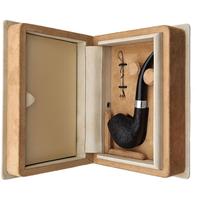I’ve hemmed and hawed for a couple of days about weighing in on the always touchy, somewhat divisive subject of vintage tobacco and the trading thereof at premium prices. And so tender my apologies in advance to anyone I inadvertently offend. To everyone else, I tender my apologies for posting at such tedious length.
As a long time buyer (and very occasionally a hobbyist seller) of vintage tobacco—not to mention occasions I’ve had to try to think critically about rare books, premium liquor, vintage wine, old cars, prewar American acoustic guitars, fashion, ridiculously expensive fragrance, postwar French bespoke randonneur bicycles, and contemporary art—I've an abiding fascination with the whole idea of what's a “fair price.” And particularly with how different worlds of well informed, experienced "insiders" view the matter and the relevant issues. My own working hypothesis—which as a generality is fairly obvious—is the devil's always in the details (i.e. the specifics of who, what, when, and where of scarcity and desire), that much it is highly subjective (to both participants and particularly to bystanders).
As for Dark Star—$285 feels high to me, too (and especially if it remains unsold indefinitely); but I’d also argue that anything that’s gone in less than 90 seconds in a once a week sale has almost certainly been priced below what I'd guess is its current going value.
What—at least to me—distinguishes the pipe world from a number of other worlds I've followed is that there really are very few professional “vintage” tobacco vendors, and there remains a comparatively large pool of very avid life long hobbyists holding a vast supply of highly sought-after tobacco (some of whom bought this at original retail release prices). What of course the pipe world does share with others—even if there are fewer of them (and some may be totally indifferent to the charms of tobacco unicorns and prefer to pursue pipes)—are new enthusiasts who want to smoke vintage tobacco or create a "cellar."
Some will have the patient temperament of hunters and love the challenges of the chase. Others—depending on their disposable income, the cost of an hour of their time, or what they’ve been willing in the recent past to pay for such similar indulgences as a Cuban cigar, a glass of bourbon or a vintage bottle of wine, may be delighted to fork over a couple of hundred dollars for a $40 bag of this year’s Penzance. Some may not want to await next year's "drop" adding their names to website waitlists (and then settle for Dunbar), or spend months of cultivating new relationships with B&Ms, or even setting their alarm clock for 9:50am CDT on a succession of Saturday mornings.
I have nothing but admiration for Steve (as a stand-up guy, who knows his stuff, loves tobacco, and has long been a persuasive ambassador for the superiority of many discontinued classic blends and cellaring) as well as what I regard as an absolutely brilliant business model.
But, if $100 (at least in my view) is low and $285 high, and there really aren’t many transactions or rival sellers, my own calculus is how much do I want it RIGHT now. (My own answer for most things is usually not enough, or I'm happy to wait.)
Nobody, including me, really wants to feel like a chump. But there are circumstances when most of us are willing, in the moment, to pay a premium—a bottle of vintage wine I may regularly drink at home, and that’s readily available at liquor stores, I expect to be priced between 2-4 times more when I go to a restaurant. And sometimes that’s just fine—indeed I may be completely thrilled to see it at all (and even think it as something of a bargain compared to everything else I see on the wine list).
Then, too, I am only too keenly aware of opportunities I’ve missed to buy (or to hold onto) things I like.
Consider, for instance, the first hardback edition of Harry Potter & the Philosopher's Stone published in 1997 by the Bloomsbury Press in London with very modest expectations about the book's prospects of becoming popular, and priced at 10.99GBP.
I suspect I may well have been in London around the time the book came out, and probably squandered about the same amount on a Dunhill Montecristo #4 or two—though of course I would have bought one or more tins of tobacco if I’d been a pipe smoker then. On the other hand, anyone smart enough to have bought a copy (or two) of Harry Potter, and then kept it/them unread in a cool dark place, would have made out rather well—the only copies in decent shape for sale right now are priced at $225,000-$350,000.
Go figure.














